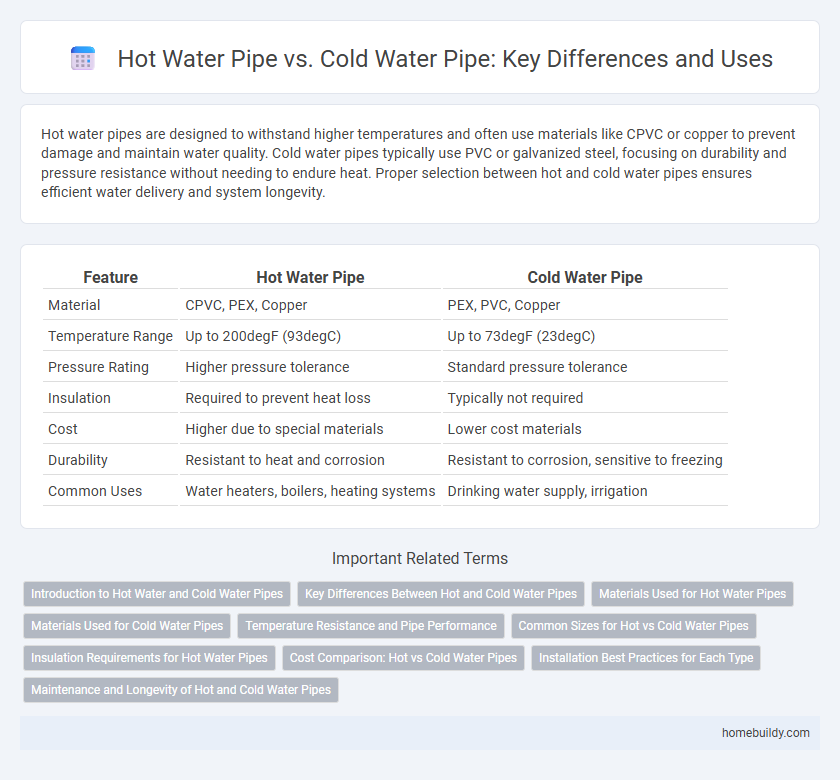Hot water pipes are designed to withstand higher temperatures and often use materials like CPVC or copper to prevent damage and maintain water quality. Cold water pipes typically use PVC or galvanized steel, focusing on durability and pressure resistance without needing to endure heat. Proper selection between hot and cold water pipes ensures efficient water delivery and system longevity.
Table of Comparison
| Feature | Hot Water Pipe | Cold Water Pipe |
|---|---|---|
| Material | CPVC, PEX, Copper | PEX, PVC, Copper |
| Temperature Range | Up to 200degF (93degC) | Up to 73degF (23degC) |
| Pressure Rating | Higher pressure tolerance | Standard pressure tolerance |
| Insulation | Required to prevent heat loss | Typically not required |
| Cost | Higher due to special materials | Lower cost materials |
| Durability | Resistant to heat and corrosion | Resistant to corrosion, sensitive to freezing |
| Common Uses | Water heaters, boilers, heating systems | Drinking water supply, irrigation |
Introduction to Hot Water and Cold Water Pipes
Hot water pipes are specifically designed to withstand higher temperatures and typically use materials like copper or cross-linked polyethylene (PEX) to prevent heat damage and corrosion. Cold water pipes, on the other hand, transport water at lower temperatures and often use materials such as PVC or CPVC due to their lower thermal requirements. Properly distinguishing between hot and cold water pipes ensures system efficiency, durability, and safety in residential or commercial plumbing installations.
Key Differences Between Hot and Cold Water Pipes
Hot water pipes are typically made from materials like copper or CPVC, designed to withstand high temperatures and prevent deformation, while cold water pipes often use PVC or PEX due to lower temperature requirements. Hot water pipes have thicker walls and are insulated to retain heat, whereas cold water pipes require minimal insulation primarily to prevent condensation. The pressure ratings also differ, with hot water pipes generally rated for higher pressures to accommodate thermal expansion and potential pressure spikes.
Materials Used for Hot Water Pipes
Hot water pipes are commonly made from materials such as copper, CPVC (chlorinated polyvinyl chloride), and PEX (cross-linked polyethylene) due to their high heat resistance and durability. Copper pipes offer excellent thermal conductivity and are corrosion-resistant, making them ideal for handling elevated temperatures in hot water systems. CPVC and PEX pipes provide flexibility and withstand hot water temperatures without degrading, ensuring long-lasting performance in residential and commercial plumbing installations.
Materials Used for Cold Water Pipes
Cold water pipes are often made from materials such as copper, PEX (cross-linked polyethylene), and PVC (polyvinyl chloride), chosen for their durability and resistance to corrosion. PEX offers flexibility and ease of installation, while copper provides excellent longevity and thermal conductivity. PVC pipes are lightweight and cost-effective, typically used in cold water supply lines due to their resistance to chemical corrosion and low heat tolerance.
Temperature Resistance and Pipe Performance
Hot water pipes are typically made from materials like CPVC or PEX, designed to withstand temperatures up to 200degF (93degC), ensuring durability and resistance to warping or bursting under thermal stress. Cold water pipes, often constructed from materials such as PVC or copper, handle lower temperature ranges, generally up to 140degF (60degC), optimizing performance without unnecessary cost or material bulk. The thermal resistance of hot water pipes directly influences their lifespan and safety in plumbing systems, while cold water pipes prioritize corrosion resistance and pressure tolerance for efficient water delivery.
Common Sizes for Hot vs Cold Water Pipes
Hot water pipes typically use 3/4-inch or 1/2-inch diameters to handle increased pressure and temperature, ensuring durability and efficient flow. Cold water pipes often range from 1/2-inch to 1-inch sizes, supporting higher flow rates with less concern for thermal expansion. Common materials for both include copper, PEX, and CPVC, with sizing chosen based on building codes and water demand requirements.
Insulation Requirements for Hot Water Pipes
Hot water pipes require insulation to prevent heat loss, maintain water temperature, and improve energy efficiency in plumbing systems. Insulation materials like foam or fiberglass specifically designed for hot water pipes reduce heat dissipation, minimizing energy costs and preventing pipe sweating that can cause damage. Properly insulated hot water pipes comply with building codes and enhance system performance by ensuring consistent hot water delivery.
Cost Comparison: Hot vs Cold Water Pipes
Hot water pipes typically cost more than cold water pipes due to their need for materials that withstand higher temperatures, such as copper or PEX designed for heat resistance. Cold water pipes can use less expensive materials like PVC or standard PEX, which reduces initial installation costs. Over time, the durability and heat tolerance of hot water pipes contribute to higher maintenance and replacement expenses compared to cold water piping systems.
Installation Best Practices for Each Type
Hot water pipes require installation with materials resistant to high temperatures, such as CPVC or copper, to prevent degradation and leaks over time. Cold water pipes can utilize more cost-effective materials like PVC or PEX, which offer flexibility and ease of installation without risking heat damage. Proper insulation is crucial for hot water pipes to maintain temperature and energy efficiency, while cold water pipes benefit from anti-condensation measures to prevent moisture buildup.
Maintenance and Longevity of Hot and Cold Water Pipes
Hot water pipes, typically made from materials like copper or CPVC, require more frequent maintenance due to higher temperatures causing accelerated wear and potential scaling buildup. Cold water pipes often use materials such as PVC or PEX, which generally exhibit longer longevity and less susceptibility to thermal stress and corrosion. Proper insulation and regular inspection extend the lifespan of both hot and cold water piping systems, reducing the risk of leaks and system failures.
Hot Water Pipe vs Cold Water Pipe Infographic

 homebuildy.com
homebuildy.com